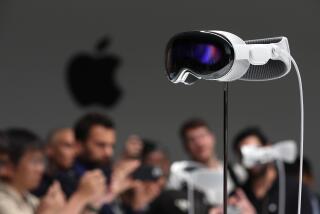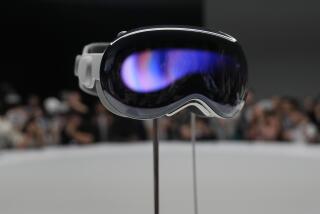3-D holographic video conferencing is real? Help me, Obi-Wan Kenobi!
- Share via
Skype and video iChat are great, but traditional video conferencing tools are so two-dimensional. Just imagine if you could talk to a friend or colleague in holographic 3-D.
Well, you may soon be able to. Researchers at Queen’s University have created a life-sized, 3-D video conferencing pod that allows users to see the person they are talking to in 360-degree holographic-like clarity.
They call it the TeleHuman.
But before images of Princess Leia telling Obi-Wan Kenobi that he is her only hope start dancing in your head, know that the 3-D holographic image only works if you have what looks like a giant cylindrical floor lamp made of acrylic that can display the life-sized 3-D holographic image in your home or office.
It’s clunky, and it’s expensive, but it’s still cool.
This innovation in video conferencing comes to you courtesy of Roel Vertegaal, director of the Human Media Lab at Queen’s Universtiy in Canada.
Although holographic video conferencing sounds very futuristic, Vertegaal and his team say they were able to put it together with existing technology.
“We basically stitched together a bunch of Kinect,” said Vertegaal in an interview with The Times, “but it was relatively complicated to get them all to work together.”
In a video about the project, the researchers explain that the pod has six Microsoft Kinect sensors at the top of the display that capture 3-D images as a person walks around the pod, and a 3-D projector in the cylindrical base of the pod creates the holographic effect.
The TeleHuman will only pick up your image if you are standing within roughly eight feet of the acrylic cylinder. Part of that is because of privacy concerns, said Vertegaal, and part of it is because that’s the farthest distance that the Kinects can pick up the image.
The researchers have programmed the Kinects to erase all the background imagery so when you show up in the other person’s pod, all they will see is your 3-D image.
Unlike traditional video conferencing, there is no “calling” or “answering” involved. In order to show up in someone else’s TeleHuman, all you have to do is walk toward your own TeleHuman and the pod on their end will start glowing with your image.
Using the same pod and similar technology, Vertegaal and his team created BodiPod -- an interactive 3-D anatomy model of the human body.
People can walk around the model and peel off layers of tissue to reveal muscles, organs and bone structure with hand signals or voice commands.
Vertegaal said he would like to see the acrylic pods come in different shapes and sizes -- maybe dinosaur shape, or perhaps Viking boat shape.
As for its use as a teleconferencing tool, he said that he thinks the TeleHuman could be available at a $5,000 price point in the next five years.
ALSO:
Yahoo confirms misleading info on new CEO’s resume
Proof! Study says checking work email is bad for your health
Berkeley freshman’s automated dorm room is a tech geek paradise
More to Read
Inside the business of entertainment
The Wide Shot brings you news, analysis and insights on everything from streaming wars to production — and what it all means for the future.
You may occasionally receive promotional content from the Los Angeles Times.











